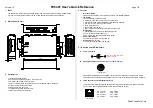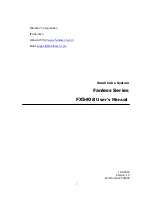
Electrical Maintenance
83
5. Check and note the battery voltage at the
battery with the unit turned off.
6. With the unit off, check the voltage at the B+
(POS) terminal on the alternator. Battery
voltage must be present. If not, check the 2A
circuit.
7. Disconnect the EXC and SENS wires in
interface harness from the voltage regulator.
8. Turn the unit on and enter Non-Running
Service Test Mode. Place the unit in Zone 1
High Speed Cool. Refer to the SPECTRUM
TS Microprocessor Diagnostic Manual for
information about the Service Test Mode.
9. Check the voltage at the sense circuit (SENS
circuit). Battery voltage should be present. If
not, check the SENS circuit in the interface
harness.
10. Check the voltage at the excitation circuit
(EXC circuit). 10 Vdc or more should be
present. If not, check the excitation circuit
(EXC circuit) in the interface harness and
check that the K1 relay is closing.
11. Turn the unit off and reconnect the EXC and
SENS wires.
12. Attach a clamp-on ammeter around the 2A
wire connected to the B+ (POS) terminal on
the alternator. All wires connected to the B+
(POS) terminal must pass thru the clamp-on
ammeter.
13. Connect a digital multi-meter between the B+
(POS) terminal at the alternator and chassis
ground.
14. Turn the unit on and allow it to start. Using the
clamp-on ammeter, check the current flow in
the 2A wire.
A positive reading indicates the alternator is
charging. On unit startup, the current flow
should momentarily increase to allow for
battery current used during preheat and
cranking. Within a short time the current
should fall to normal unit load plus charge
current to the unit battery (typically 5-10
amps).
A reading on the clamp-on ammeter at or near
0 amps indicates the alternator is not charging.
Checking the unit ammeter will show a
discharge condition. The alternator is
defective if there are no problems in the
wiring. Recheck the wiring before assuming
the alternator is defective.
15. Check the voltage at the B+ (POS) terminal.
The voltage should increase until it reaches
the anticipated voltage regulator setting as
shown in the table below. Record the voltage.
The voltage regulator setting varies inversely
with the temperature as shown below.
Regulator voltage can vary from
approximately 15.2 Vdc at -40 F (-40 C) to
approximately 13.2 Vdc at 176 F (80 C).
If the voltage does not increase to the
anticipated voltage regulator setting, the
alternator is defective if there are no problems
in the wiring. Recheck the wiring before
replacing the alternator.
16. If the voltage does increase until it reaches the
anticipated voltage regulator setting, compare
the voltage at the B+ (POS) terminal to the
voltage between the battery terminals. The
voltage at the B+ (POS) terminal should be no
more than 1.0 Vdc higher than the voltage
between the battery terminals.
If the voltage at the B+ (POS) terminal is no
more than 1.0 Vdc higher than the voltage
between the battery terminals, continue with
Step 17.
CAUTION: Energizing the circuit with
the resistor bypass fuse installed will
damage Bosch and Thermo King Powder
Coated alternators. Be sure the resistor
bypass fuse is removed with Bosch and
Thermo King Powder Coated alternators.
Be sure the resistor bypass fuse is installed
with Prestolite alternators.
Temperature
Anticipated Regulator Voltage
-40 F (-40 C)
From 15.2 Vdc to 14.0 Vdc
77 F (25 C)
From 14.4 Vdc to 13.6 Vdc
176 F (80 C)
From 14.2 Vdc to 13.2 Vdc
Содержание SPECTRUM TS 30 SR NAD
Страница 4: ...4 ...
Страница 10: ...Table of Contents 10 ...
Страница 20: ...Safety Precautions 20 ...
Страница 51: ...Unit Description 51 Figure 19 Front View Figure 20 Back View AJA1350 AJA1500 ...
Страница 52: ...Unit Description 52 1 On Off Switch Figure 21 Side View 1 ...
Страница 60: ...Unit Description 60 ...
Страница 80: ...SPECTRUM TS Operation 80 ...
Страница 90: ...Electrical Maintenance 90 ...
Страница 100: ...Engine Maintenance 100 Figure 130 Early TK 3 95 Fuel and Oil System Components ...
Страница 102: ...Engine Maintenance 102 Figure 131 Late TK 3 95 Fuel and Oil System Components ...
Страница 104: ...Engine Maintenance 104 Figure 132 TK376 Fuel and Oil System Components ...
Страница 136: ...Refrigeration Maintenance 136 ...
Страница 156: ...Hilliard Clutch Maintenance 156 ...
Страница 158: ...Structural Maintenance 158 ...
Страница 168: ...Remote Evaporator Specifications 168 ...
Страница 170: ...Remote Evaporator Maintenance Inspection Schedule 170 ...
Страница 176: ...Remote Evaporator Electrical Maintenance 176 ...
Страница 180: ...Remote Evaporator Refrigeration Service Operations 180 ...
Страница 182: ...Remote Evaporator Structural Maintenance 182 ...
Страница 184: ...Remote Evaporator System Diagnosis 184 ...
Страница 188: ...Wiring and Schematic Diagrams Index 188 ...
Страница 189: ...189 Wiring Diagram Page 1 of 4 ...
Страница 190: ...190 Wiring Diagram Page 2 of 4 ...
Страница 191: ...191 Wiring Diagram Page 3 of 4 ...
Страница 192: ...192 Wiring Diagram Page 4 of 4 ...
Страница 193: ...193 Schematic Diagram Page 1 of 3 ...
Страница 194: ...194 Schematic Diagram Page 2 of 3 ...
Страница 195: ...195 Schematic Diagram Page 3 of 3 ...
Страница 196: ...196 ...
















































